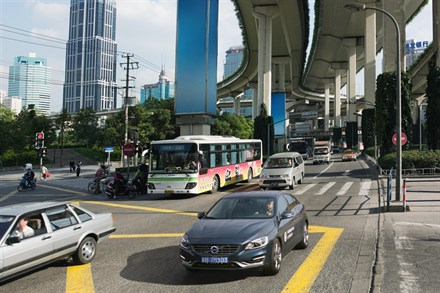The first call for joint road safety research between China and Sweden has now received its first projects, several are included in SAFER's project portfolio
The joint projects are a result of fruitful collaborations within the CTS platform, which SAFER has been involved in since its start in 2012. The funding is shared by Vinnova in Sweden and the Ministry of Science and Technology of China (MOST). The overall target is to create opportunities for bilateral collaboration with China in the field of traffic safety, but also in life science and applied ICT. The purpose is to improve research, development and innovation that leads to increased traffic safety and better health in Sweden and other countries.
Three projects have currently been approved in the first common call and will be placed in SAFER's project portfolio.
Magnus Granström, SAFER’s director, says:
“This is a clear result of persistent work within the platform, leading up to this joint call where we for the first time are able to have projects that run in parallel in Sweden and China and have a common goal. What we have learnt from this process is that it takes time both to find suitable ways of working between the partners, but also between the governmental agencies”
Virtual Evaluation Tools for Pedestrian (Safer pedestrians)
Safer Pedestrians addresses new challenges regarding safety of road users outside the vehicle. Pedestrian, cyclists, and other new personal mobility devices operate in many areas shared with motor vehicles with, and without, automation. This project will combine the expertise of Swedish and Chinese researchers to advance current safety evaluation technologies with the Swedish team focusing on the evaluation of injury assessment.
Future safety systems must address changing mobility trends. Current development and assessment approaches for vulnerable road users depend on overly simplified component tests that cannot address the diversity of road users. The Swedish contribution to the project is to develop open source computational mechanics tools that can be used by the automotive industry and independent researchers. These tools will facilitate new protective strategies and allow society to address changes arising as automation and an ageing society creates new traffic safety situations.
The SAFER partners are Chalmers, VTI, Autoliv, Volvo Cars and they work together with Tsinghua University in Beijing, Geely, RIOH, Brillizance Auto. Rob Thomson is leading the project.
Heterogeneous Traffic Groups Cooperative Driving Behaviours Research under Mixed Traffic Condition
The development and application of automated driving technology has shown a great perspective in improving traffic safety and traffic efficiency. It will bring tremendous impact and subversive changes to the operating mode of the entire traffic system. It will also be the future direction of the traffic system development. However, since the technology is not yet mature, it can be foreseen that the situation of automated driving mixed with manual driving will last for a long time in the preliminary stage of automated driving. Therefore, the project team plan to in-depth study the coupling relationship between different automated driving behaviours and manual driving behaviour, research the traffic control theory under mixed traffic circumstance and research and explore the intelligent cooperative control strategy for heterogeneous traffic groups. The project will also formulate a traffic control algorithm of automated driving cooperative strategy under the mixed traffic circumstance and develop corresponding simulation and analysis tools.
Holistic and integrated emergency management technology & equipment in the event of traffic accidents
Emergency management (EM), which is strategic to approach the vision of zero death, needs efficient cooperation among multiple stakeholders including medical services, public safety answering point (PSAP, or SOS), police departments, infrastructure planners, and traffic operators. The current disaggregated practice of EM in both China and Sweden is in high need of improvement. In this joint proposal, we intend to develop a holistic and integrated EM system that is able to take into account pre-hospital screening, hospital selection, EV optimal routing, intelligent infrastructure adaptation, traffic flow control and congestion management, V2X communication, and system integration. This project is in collaboration with a Chinese team led by Changjiang Chair Professor Wei Wang. The Swedish team includes four research institutions (Chalmers: traffic flow control; RISE: system integration; Uppsala: optimal routing; and VTI: traffic safety and EM), and four industry partners (Medfield diagnostics AB: to develop the equipment of pre-hospital fast evaluation; H&E Solutions: to develop in-vehicle equipment for V2X communication; WSPAB: intelligent infrastructure and service provider; FellowBot AB: EV location planning). The market and social potentials of this proposed research are immense. By improving the current practice of emergency management, thousands of lives can be saved and ultimate goal of zero death becomes more realistic. The developed technologies and equipment can also be used by other areas related to emergency management such as evacuation and disaster response.
The consortium is led by Professor Xiaobo Qu of Chalmers University of Technology, and partners includes RISE Viktoria, VTI, Uppsala University, Medfields, WSP AB, H&E Solutions, FellowBot, Southeast Unviersity, Hong Kong Polytechnic University, and Ministry of Public Security Transport Management Research Institute.

